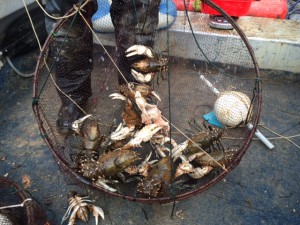Murray Crayfish Part 1: Tracking recovery of populations impacted by blackwater disturbance
 Over the past four years, we have continued monitoring populations in the Murray River that had suffered significant (80% decline) population loss due to the 2010‒11 extreme blackwater event. Over that time, we have only observed a gradual increase in the abundance of affected populations, and the species has not been detected at almost one-third of sites post-blackwater. So, recovery is going slow and this is not unexpected (our population modelling indicated it may take decades for populations to increase to pre-disturbance levels). Clearly, sound management is needed as well as conservation actions that help to speed up the recovery of impacted areas.
Over the past four years, we have continued monitoring populations in the Murray River that had suffered significant (80% decline) population loss due to the 2010‒11 extreme blackwater event. Over that time, we have only observed a gradual increase in the abundance of affected populations, and the species has not been detected at almost one-third of sites post-blackwater. So, recovery is going slow and this is not unexpected (our population modelling indicated it may take decades for populations to increase to pre-disturbance levels). Clearly, sound management is needed as well as conservation actions that help to speed up the recovery of impacted areas.
Our monitoring also focuses on areas that were not impacted by the blackwater disturbance and remain open to recreational fishing. Our monitoring has shown that these populations remain healthy (see left) and that the fishery regulations changes (increasing length limit, reducing how many crayfish can be taken) appear to be working as we are observing more larger individuals, which are mature and capable of contributing more offspring to future generations (our population modelling supports this too). It is great to be able to inform management changes and they demonstrate their benefits.
Thanks to the NSW Recreational Fishing Freshwater Trust for funding this monitoring, which will continue in future years.
